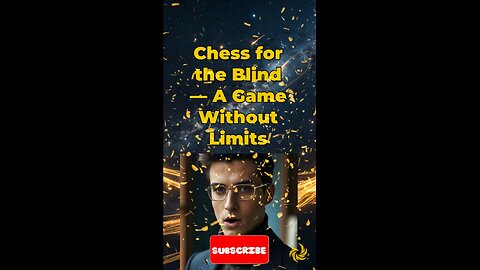
ChessFacts
3 videos
Updated 6 months ago
Amazing and little-known facts about chess — from ancient legends to modern records. Intrigue, mystery, and the true magic of the game in short video format. New episodes weekly.
-
3 Chess Fact. Chess for the Blind — A Game Without Limits
 Golden Falcons Chess ClubIn the 19th century, blind individuals aspired to participate in intellectual games like chess. While specialized tactile chessboards emerged later, Louis Braille's development of the raised-dot writing system in 1824 was a pivotal step in making information accessible to the blind, including the game of chess. The world's first official chess tournament for blind players was held in 1938 in the Soviet Union, organized by the All-Russian Society of the Blind. Already at that time, players used special boards with indented squares and tactile pieces: black pieces with spikes and white pieces smooth to the touch. Since then, chess has become one of the most important intellectual disciplines for people with visual impairments. The idea of using tactile chessboards with indented squares and distinguishable pieces by touch was implemented in the mid-20th century and became an international standard thanks to the efforts of the International Braille Chess Association (IBCA). Today, major international tournaments and championships for blind chess players are regularly organized by the International Braille Chess Association (IBCA). Among blind chess players, there are International Masters and even Grandmasters. For example, Grandmaster Marcin Tazbir from Poland is one of the strongest players in the world. How do blind players compete? • They use specially adapted tactile boards with locking mechanisms for the pieces. • Players announce their moves aloud for accuracy and recordkeeping. • In matches against sighted opponents, two synchronized boards are used — one tactile, one regular. Blind chess shows that intelligence and strategy can go far beyond sight. Sources: - International Braille Chess Association (IBCA) The official IBCA website, providing information on tournaments, player rankings, and rules for blind chess players. 🔗 ibca-info.org - International Braille Chess Association – Wikipedia Article detailing the history and activities of IBCA, including information on tournaments and rules for blind chess players. 🔗 en.wikipedia.org/wiki/International_Braille_Chess_Association - Louis Braille: Renowned for inventing the Braille system, which revolutionized reading and writing for the blind. 🔗 Louis Braille - Wikipedianbp.org+5 Photo: - Marcin Tazbir, Polish Chess Cup, Łódź 2021. By This photo was taken by Krzysztof SzelągAutorem zdjęcia jest Krzysztof SzelągWykorzystując zdjęcie proszę podać jako autora:Krzysztof Szeląg / Wikimedia Commons - Own work, CC BY-SA 4.0, https://commons.wikimedia.org/w/index.php?curid=109681432 - chessboard for blind players. By rorkhete - Own work, CC BY-SA 3.0, https://commons.wikimedia.org/w/index.php?curid=2264256 - Blind chess demonstration by Paul Lipke at the Anderssen Chess Club in Frankfurt am Main. Wikipedia:Public domain - Russische schaakgrootmeester Tigan Petrosjan speelt simultaan tegen blinde jongen te Nijmegen. Creative Commons Zero, Public Domain Dedication. https://commons.wikimedia.org/wiki/File:Russische_schaakgrootmeester_Tigan_Petrosjan_speelt_simultaan_tegen_blinde_jonge,_Bestanddeelnr_910-9183.jpg - Louis Braille. By Unknown author - Common Portrait of Louis Braille doctored by myself. Over 100 Years old., Public Domain, https://commons.wikimedia.org/w/index.php?curid=495355 #chess #blindchess #gamewithoutlimits #inclusivechess #interestingfacts #chessfacts #ChessShortSeries20 views
Golden Falcons Chess ClubIn the 19th century, blind individuals aspired to participate in intellectual games like chess. While specialized tactile chessboards emerged later, Louis Braille's development of the raised-dot writing system in 1824 was a pivotal step in making information accessible to the blind, including the game of chess. The world's first official chess tournament for blind players was held in 1938 in the Soviet Union, organized by the All-Russian Society of the Blind. Already at that time, players used special boards with indented squares and tactile pieces: black pieces with spikes and white pieces smooth to the touch. Since then, chess has become one of the most important intellectual disciplines for people with visual impairments. The idea of using tactile chessboards with indented squares and distinguishable pieces by touch was implemented in the mid-20th century and became an international standard thanks to the efforts of the International Braille Chess Association (IBCA). Today, major international tournaments and championships for blind chess players are regularly organized by the International Braille Chess Association (IBCA). Among blind chess players, there are International Masters and even Grandmasters. For example, Grandmaster Marcin Tazbir from Poland is one of the strongest players in the world. How do blind players compete? • They use specially adapted tactile boards with locking mechanisms for the pieces. • Players announce their moves aloud for accuracy and recordkeeping. • In matches against sighted opponents, two synchronized boards are used — one tactile, one regular. Blind chess shows that intelligence and strategy can go far beyond sight. Sources: - International Braille Chess Association (IBCA) The official IBCA website, providing information on tournaments, player rankings, and rules for blind chess players. 🔗 ibca-info.org - International Braille Chess Association – Wikipedia Article detailing the history and activities of IBCA, including information on tournaments and rules for blind chess players. 🔗 en.wikipedia.org/wiki/International_Braille_Chess_Association - Louis Braille: Renowned for inventing the Braille system, which revolutionized reading and writing for the blind. 🔗 Louis Braille - Wikipedianbp.org+5 Photo: - Marcin Tazbir, Polish Chess Cup, Łódź 2021. By This photo was taken by Krzysztof SzelągAutorem zdjęcia jest Krzysztof SzelągWykorzystując zdjęcie proszę podać jako autora:Krzysztof Szeląg / Wikimedia Commons - Own work, CC BY-SA 4.0, https://commons.wikimedia.org/w/index.php?curid=109681432 - chessboard for blind players. By rorkhete - Own work, CC BY-SA 3.0, https://commons.wikimedia.org/w/index.php?curid=2264256 - Blind chess demonstration by Paul Lipke at the Anderssen Chess Club in Frankfurt am Main. Wikipedia:Public domain - Russische schaakgrootmeester Tigan Petrosjan speelt simultaan tegen blinde jongen te Nijmegen. Creative Commons Zero, Public Domain Dedication. https://commons.wikimedia.org/wiki/File:Russische_schaakgrootmeester_Tigan_Petrosjan_speelt_simultaan_tegen_blinde_jonge,_Bestanddeelnr_910-9183.jpg - Louis Braille. By Unknown author - Common Portrait of Louis Braille doctored by myself. Over 100 Years old., Public Domain, https://commons.wikimedia.org/w/index.php?curid=495355 #chess #blindchess #gamewithoutlimits #inclusivechess #interestingfacts #chessfacts #ChessShortSeries20 views -
2 Chess Fact. Najdorf’s 45 Blindfold Games — and He Crushed Them.
 Golden Falcons Chess ClubOn January 20, 1947, in São Paulo, Brazil, Argentine grandmaster Miguel Najdorf — originally from Poland —played 45 blindfold chess games simultaneously. He couldn’t see a single board. Every move, every piece, every position was memorized and tracked entirely in his mind. For 24 hours straight, he fought his opponents and achieved a phenomenal score: – 39 wins – 2 draws – 4 losses – a win percentage of 86.6%. This wasn't just a chess stunt — it was also a desperate hope. Najdorf had lost contact with his family after World War II. He hoped the world-record feat would make global headlines… and maybe help him find his loved ones. Recognized by the Guinness Book of Records, his performance remained unbeaten for decades. It proved that intelligence, willpower, and memory matter just as much as sight in chess. His record shook the world. But what happened next — and who dared to rewrite it — is another, no less thrilling story. Photo by Miguel Najdorf: Wikimedia Commons (CC0 1.0 Public Domain)27 views
Golden Falcons Chess ClubOn January 20, 1947, in São Paulo, Brazil, Argentine grandmaster Miguel Najdorf — originally from Poland —played 45 blindfold chess games simultaneously. He couldn’t see a single board. Every move, every piece, every position was memorized and tracked entirely in his mind. For 24 hours straight, he fought his opponents and achieved a phenomenal score: – 39 wins – 2 draws – 4 losses – a win percentage of 86.6%. This wasn't just a chess stunt — it was also a desperate hope. Najdorf had lost contact with his family after World War II. He hoped the world-record feat would make global headlines… and maybe help him find his loved ones. Recognized by the Guinness Book of Records, his performance remained unbeaten for decades. It proved that intelligence, willpower, and memory matter just as much as sight in chess. His record shook the world. But what happened next — and who dared to rewrite it — is another, no less thrilling story. Photo by Miguel Najdorf: Wikimedia Commons (CC0 1.0 Public Domain)27 views -
1 Chess Fact “Checkmate”: What Does It Really Mean?
 Golden Falcons Chess Club🔹 Detailed Story and Background 🗓 Historical Period: Early Middle Ages (~7th–9th century CE) 📍 Region: Persia (modern-day Iran), later expanded to Arabic-speaking regions and Europe 🔠 Origin of the Term: The term "checkmate" comes from the Persian phrase "Shāh Māt" (شاه مات). • "Shāh" means "king" in Persian. • "Māt" does not literally mean "dead" but rather "helpless," "defeated," or "powerless." Thus, the phrase "Shāh Māt" translates more accurately to "the king is helpless" or "the king is checkmated", not necessarily "the king is dead" (a common but imprecise interpretation). ________________________________________ 🧭 Linguistic and Historical Journey: • The game of chess evolved from Chaturanga, an Indian board game, and was later adopted and modified by the Persians as Shatranj. • As the game spread across the Islamic world and into Europe, many terms were borrowed or adapted linguistically: o From Persian to Arabic o From Arabic to Latin o From Latin into Old French → Modern English • The word "checkmate" in English is derived from this linguistic journey. ________________________________________ 🎓 Linguistic Insight: • The Persian word "māt" is rooted in a verb meaning "to be defeated" or "to remain still", not directly "to die." • This subtle distinction gives the phrase a symbolic and poetic power: it's not that the king is slain, but that he can no longer act — his options are gone. ________________________________________ 📝 Why It Matters: • This phrase is one of the most iconic endings in any game, and it reflects chess's deep historical and cultural layers. • Understanding its true origin helps connect chess not just to logic and tactics — but to language, poetry, and the ancient world. 📚 Sources & References: 1. Oxford English Dictionary – entry for “checkmate”: https://www.oed.com/view/Entry/31217 2. Encyclopaedia Iranica – Entry: Chess (Shatranj): https://iranicaonline.org/articles/chess 3. David Shenk, The Immortal Game: A History of Chess (2006) – Chapter 3 [ISBN: 9780385531601] 4. The Oxford Companion to Chess by Hooper & Whyld (2nd Ed., p.76) [Oxford University Press, 1992] 5. Edward Winter’s Chess Notes – Linguistic exploration of "Shah Mat": https://www.chesshistory.com/winter/extra/checkmate.html31 views
Golden Falcons Chess Club🔹 Detailed Story and Background 🗓 Historical Period: Early Middle Ages (~7th–9th century CE) 📍 Region: Persia (modern-day Iran), later expanded to Arabic-speaking regions and Europe 🔠 Origin of the Term: The term "checkmate" comes from the Persian phrase "Shāh Māt" (شاه مات). • "Shāh" means "king" in Persian. • "Māt" does not literally mean "dead" but rather "helpless," "defeated," or "powerless." Thus, the phrase "Shāh Māt" translates more accurately to "the king is helpless" or "the king is checkmated", not necessarily "the king is dead" (a common but imprecise interpretation). ________________________________________ 🧭 Linguistic and Historical Journey: • The game of chess evolved from Chaturanga, an Indian board game, and was later adopted and modified by the Persians as Shatranj. • As the game spread across the Islamic world and into Europe, many terms were borrowed or adapted linguistically: o From Persian to Arabic o From Arabic to Latin o From Latin into Old French → Modern English • The word "checkmate" in English is derived from this linguistic journey. ________________________________________ 🎓 Linguistic Insight: • The Persian word "māt" is rooted in a verb meaning "to be defeated" or "to remain still", not directly "to die." • This subtle distinction gives the phrase a symbolic and poetic power: it's not that the king is slain, but that he can no longer act — his options are gone. ________________________________________ 📝 Why It Matters: • This phrase is one of the most iconic endings in any game, and it reflects chess's deep historical and cultural layers. • Understanding its true origin helps connect chess not just to logic and tactics — but to language, poetry, and the ancient world. 📚 Sources & References: 1. Oxford English Dictionary – entry for “checkmate”: https://www.oed.com/view/Entry/31217 2. Encyclopaedia Iranica – Entry: Chess (Shatranj): https://iranicaonline.org/articles/chess 3. David Shenk, The Immortal Game: A History of Chess (2006) – Chapter 3 [ISBN: 9780385531601] 4. The Oxford Companion to Chess by Hooper & Whyld (2nd Ed., p.76) [Oxford University Press, 1992] 5. Edward Winter’s Chess Notes – Linguistic exploration of "Shah Mat": https://www.chesshistory.com/winter/extra/checkmate.html31 views

